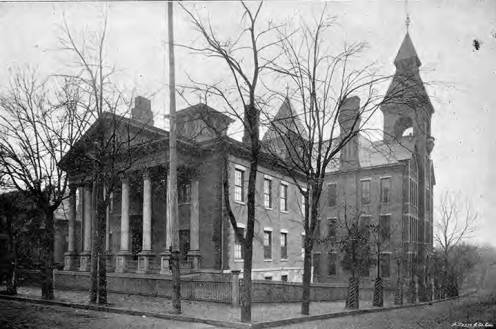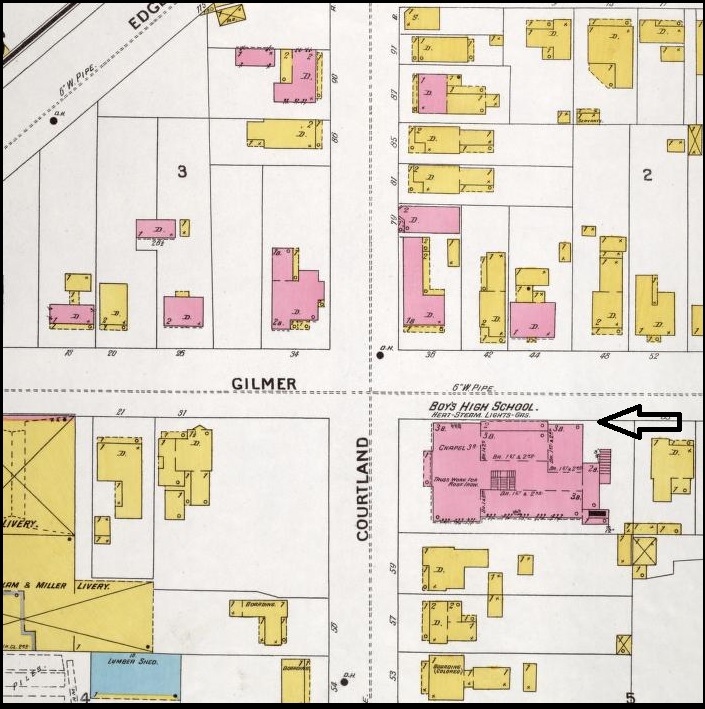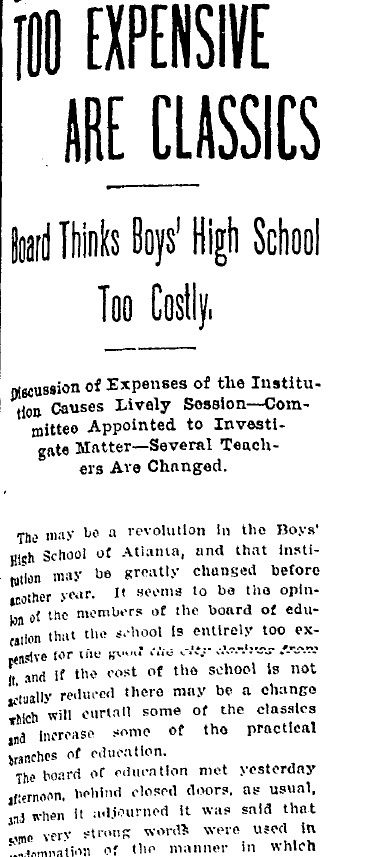
In “Eternally Forgotten Atlanta Public Schools – Pt. 1 – Elementary Schools,” I discussed the early history of the Atlanta Public School system, officially opening its doors in 1872. Once it opened, APS had opened 3 elementary schools and two high schools for Caucasian students. Over time, more high schools would open and ultimately boys and girls high schools would go on to be consolidated into one school by the late 1940’s. This post will focus on the very first boys and girls high schools opened 1872.
Girl’s High School ( Feb. 5, 1872 – 1945?):
Girl’s High School, originally located at 66 Whitehall Street on the corner of Whitehall and Hunter Streets, served as the first and only high school for girls in 1872. Most students who graduated from the first three grammar schools (Ivy Street, Crew Street, and Walker Street) would have enrolled in either Boys or Girls High School. When the school first opened, 171 girls, were enrolled. That number would more than double in later years. At this time, both Boys High and Girls High occupied the same shop building until a permanently constructed schoolhouse was built; the 1878 Atlanta City Directory lists the combined schools as the “Atlanta High School.” In 1873, Girls High was moved to the John Neal Home (the John Neal Home would be later demolished in 1928 to make way for Atlanta City Hall) as it was still without a permanent home located at the corners of Washington and Mitchell Streets. Finally, in a three-story brick building would be erected behind the John Neal Home in 1888, where Girls High would remain until January 1925. Little did the students of Girls High know, this final move would not be their last.
Due to robust growth in Atlanta’s population, the city of Atlanta began to expand which brought on a demand for more land. Also, as a result of the booming population, Girls High began to burst at the seams with student enrollment. Let’s not forget the poor conditions of the school, with it dank, dark and poorly ventilated classrooms Girls High was long overdue for new facilities. Petitions for a larger and more state-of-the-art facility were soon underway. Board of Education President Walter Daley declared in 1912 that the Girls High facility was a “monstrosity,” and “…and embarrassment to the City of Atlanta.”
In 1920, Atlanta’s Major Key deemed the old Girls High building as “unfit,” declaring that a new building is underway with an anticipated opening date of 1922. At an estimated $500,000 (in 1922 of course), the new school promised to afford both students and teachers with every comfort imaginable. Unfortunately, the new school’s grand opening would ultimately be delayed due to funding issues. Unbeknownst to most, the Boys High School (now known as Grady High) was under construction at the same time a Girls High. Since it would be deemed illegal to borrow funds from the Boys High school construction, further building plans for Girls High would be delayed for another year or so. Delayed twice in 1923, the new Girls High couldn’t fully open its doors until January 5, 1925, with 750 pupils enrolled. Girls High School’s new location would officially be listed as 745 Rosalia Street in the Grant Park area.
Serving the Atlanta area as the premier school for high school girls, Girls High enjoyed almost thirty years of operation at its new location. Girls High would even become pretty famous in the 1930’s after a visit from then-Presidental hopeful Franklin D. Roosevelt. Students would be able to enjoy classrooms suited for upwards of 35 students, a grand library with 14,000 books, and more importantly, electricity, indoor plumbing, and heating. The typical curriculum at the time consisted of business management, sewing, cooking, home economics, housekeeping, and music.
By 1947, Girls High would no longer exist as the new co-educational community high school program would go into effect. Schools would no longer be separated by gender, thereby moving the Girls High student body into Boys High. This would lead to the renaming of Boys High as what it is better known as today – Henry W. Grady Highschool. The old Girls High school would later be named as Roosevelt High School. After 75 years, Girls High became a distant memory in the minds of modern Atlantans.

Boys High School (January 1872 – 1947):
Boys High School endured a very unstable past from its inception to the time that it ultimately was converted into a coed facility in the late 1940’s. Before finally settling into a permanent location, Boys High School’s faculty, staff, and students would move a total of eight times by 1924. It’s final chapter, however, became a proud history. I have a personal connection to Boys High that I will discuss later in this post.
Boys High endured a rocky start, similarly to Girls High, as it shared a department store facility with Girls High. Additionally, Boys High was located in the basement of the newly built Girls High, on the corner Washington and Mitchell street before moving into its own building. The first principal of the newly opened Boys High was William F. Slaton (1874 – 1879), who would eventually move on to become the superintendent of Atlanta Public Schools in 1879. From the very beginning, Boys High experienced overcrowding and dangerous conditions.

Boys High original wooden structure would be deemed too dangerous to remain open, therefore the city of Atlanta decided to build a more modern, fireproof structure for Boys High. In 1894, Boys High would no longer be located at Washington and Mitchell Streets; the new Boys High would now be located at the corner of Courtland and Gilmer streets, replacing the old Toon house. The Toon house belonged to a confederate soldier named Joshua J. Toon, who moved to Atlanta in 1860 and built the home with confederate money (to the tune of $25,000). After Toon’s death in 1893, the city of Atlanta purchased the land to be utilized as the new location for Boys High School. According to monthly reports in the Atlanta Constitution, Boys High pupils were some of the brightest and most talented students in the state of Georgia. Many would go on to become college graduates, influential businessmen, and local elected officials. Perhaps the school’s curriculum reputation is the reasoning behind the ample amount of school applicants it would receive each school terms. Whatever the reason, one thing is for sure, the school board grossly underestimated the steady growth of Atlanta Public School enrollment, with the total number of students enrolled reaching 20,000 by 1896, the board quickly realized that Boys High could not enroll each student that applied, due to the limited seating. To remedy the issue, talks of building another school for high school boys began to surface.

In 1908, the local newspaper published an article concerning the poor conditions of the old Boys High School. The old wooden structure was plagued with no fire escapes, rickety framework, dilapidated staircases, poor ventilation,, overcrowded classrooms, and infestation of vermin. By all accounts, the school board was justified in its claims of condemnation of Boys High. Journalist Steven Johnston insisted that the board of education should appropriate more funding to provide more adequate curriculum, safe conditions and competitive pay for faculty. Overall, it appears that Boys High was in need of a more than a facelift; it needed a complete overhaul.
In addition to complaints of overcrowding, the cost of operating Boys High began to cause a stir around the city of Atlanta. In an August 27, 1904, Atlanta Constitution article, the school board complained of the soaring costs to operate Boys High due to its dual programs (business, classical, and technological programs) and overcrowded classrooms. To remedy the issue, in 1909, the technological portion of Boys High moved into the then abandoned Marietta grammar school building, while the traditional college preparatory based Boys High, remained in the same location. By moving the technological portion of Boys High, the board managed to remedy soaring operational costs, but it did little to remedy the overcrowding issues. Several articles pleading and urging the board to appropriate funds for a new building were published from 1911 – 1915. Built for a class size of 200, Boys High was now housing over 400 students by 1911. In 1912, Tech High’s new location within the old, ramshackle Marietta grammar school was literally falling apart as well. With the roof caving in, and the building itself threatening to fall down, many urged the city to provide a new location for Tech High as well.
By the 1920’s, the cries and demands for a new building for both Tech and Boys High were answered. Construction for the new school began in the Spring of 1923 which a scheduled grand opening in January of 1925. In order to save costs and remedy the overcrowding concerns, the board voted to house both Tech High and Boys High into one building in 1924. Unfortunately, due to a devastating fire, Boys High would once more find itself in makeshift, temporary housing. Boys High moved into the abandoned Walker Street grammar school building until the fall of 1924. After the Fall of 1924, Boys High would move into its final location on Charles Allen Drive and 10th streets. Citing the successes of merged Hoke High and Commercial High School, APS superintendent H.R. Hunter approved the idea to combine both Tech High and Boys High under one roof. Tech High would occupy seven-eighths of the new building Boys High would occupy just under three-fourths of the new building.
The new school building would be able to accommodate up to 1,500 students, with at least 40 classrooms, a stark difference from the original tiny school house. The size of Boys High School wasn’t the only drastic change. In addition to a large facility, the newly consolidated Tech High and Boys High would now be known as Henry W. Grady High School. Former Tech and Boys High students recall the literal white line drawn on the back of the school to separate both schools. While they were friends with one another, that friendship would be tested when both Tech and Boys High would compete in the annual football tournament. The event was said to draw thousands of onlookers
Over the years, Henry W. Grady High School would go through many changes both physically and internally. Several expensive additions were made to Grady High School including a new auditorium and gymnasium in 1937 ($130,000 price tag; utilizing WPA and bond funds) to accommodate a growing student body. Eight years later in 1945, Henry W. Grady would change internally as well, with the abolishment of separate high schools for boys and girl. The Board of Education voted to convert Henry W. Grady High School into a coeducational institution to accommodate 3,000 students at a cost of $650,000. The merger was finalized in the fall of 1948, marking the official closure of Boys High after a successful seventy-six years in operation. Henry W. Grady High School would go on to become the first high school in Atlanta to integrate (August 29, 1961).
As of 2016, there are a little over 430 alumni remaining. Remaining alumni meet occasionally to reminisce about the olden days before Boys and Tech High became Henry W. Grady High School. Many of the Boys High alumni have gone on to become major movers and shakers of Atlanta and elsewhere. Notable alumni would include S. Truett Cathy, Class of 1939 (Boys High School) Founder of Chik-Fil-A, Eric Roberts (Actor) class of 1974, Yolanda King (daughter of Dr. Martin Luther King Jr), class of 1972, Richard Lenny (CEO of Hershey Corp) class of 1970, and a host of other political and businessmen and women. After the closure of Boys High and merger of Girls High school, Henry W. Grady High would go on to become one of Atlanta’s public school gems. The school would also go on to make history, becoming the first school in Atlanta to desegregate (August 29, 1961). Grady High School is still in operation today as the magnet school for communications.
Sources:
- NEW GIRLS’ HIGH SCHOOL PROMISED.” 1920.The Atlanta Constitution (1881-1945), Dec 10, 7. http://ezproxy.gsu.edu/login?url=http://search.proquest.com.ezproxy.gsu.edu/docview/497701644?accountid=11226.
- “Girls High Grads Planning 75th, Final Homecoming.” 1947.The Atlanta Constitution (1946-1984), Apr 30, 7. http://ezproxy.gsu.edu/login?url=http://search.proquest.com.ezproxy.gsu.edu/docview/1533175100?accountid=11226.
- https://en.wikipedia.org/wiki/Girls_High_School_(Atlanta)
- http://www.blackpast.org/aah/first-congregational-church-atlanta-georgia-1867
- http://onsummerhill.org/history-of-summerhill/
- Acheson. 1897. “THE SUMMERHILL SCHOOL THE OLDEST NEGRO SCHOOL.” The Atlanta Constitution (1881-1945), Mar 09, 4. http://ezproxy.gsu.edu/login?url=http://search.proquest.com.ezproxy.gsu.edu/docview/495387504?accountid=11226.
- Williams, Donna. 1981. “Residents Find New Home A ‘Capitol’ Idea.” The Atlanta Constitution (1946-1984), May 21, 1. http://ezproxy.gsu.edu/login?url=http://search.proquest.com.ezproxy.gsu.edu/docview/1621644666?accountid=11226.
- Dooly, Isma. 1915. “Committee of Atlanta Men and Women Find Public Schools are Deplorably Inadequate.” The Atlanta Constitution (1881-1945), Apr 18, 3. http://ezproxy.gsu.edu/login?url=http://search.proquest.com.ezproxy.gsu.edu/docview/496685213?accountid=11226.
- “BOYS’ HIGH SCHOOL CONGRATULATED ON 60TH ANNIVERSARY.” The Atlanta Constitution (1881-1945), Jan 31, 1932. http://ezproxy.gsu.edu/login?url=http://search.proquest.com.ezproxy.gsu.edu/docview/501482284?accountid=11226.
- “TOO EXPENSIVE ARE CLASSICS.” The Atlanta Constitution (1881-1945), Aug 27, 1904. http://ezproxy.gsu.edu/login?url=http://search.proquest.com.ezproxy.gsu.edu/docview/495906609?accountid=11226.
- “Work Will Begin on Boys’ Senior High School Soon.” The Atlanta Constitution (1881-1945), Apr 13, 1923. http://ezproxy.gsu.edu/login?url=http://search.proquest.com.ezproxy.gsu.edu/docview/498943834?accountid=11226.
- http://saportareport.com/boys-high-legacy-lives-on-through-800000-gift-to-grady-high/
- “NEW HIGH SCHOOLS PLANNED FOR CITY.” The Atlanta Constitution (1881-1945), Apr 09, 1912. http://ezproxy.gsu.edu/login?url=http://search.proquest.com.ezproxy.gsu.edu/docview/496585473?accountid=11226.
- “Hundreds of Children Will be Turned Away from Public Schools of Atlanta Next Year; City Faces Unprecedented, Critical Situation.” The Atlanta Constitution (1881-1945), Nov 22, 1914. http://ezproxy.gsu.edu/login?url=http://search.proquest.com.ezproxy.gsu.edu/docview/496696988?accountid=11226.
- “TECH HIGH AND BOYS’ HIGH PLEAD FOR NEW BUILDINGS.” The Atlanta Constitution (1881-1945), Mar 17, 1912. http://ezproxy.gsu.edu/login?url=http://search.proquest.com.ezproxy.gsu.edu/docview/496633820?accountid=11226.
- “CITY SCHOOL LOTS SOLD TOO CHEAP, COMMISSION TOLD.” The Atlanta Constitution (1881-1945), Nov 08, 1923. http://ezproxy.gsu.edu/login?url=http://search.proquest.com.ezproxy.gsu.edu/docview/499095177?accountid=11226.
- “TECHNICAL DEPT, GIVEN A SCHOOL.” The Atlanta Constitution (1881-1945), Jul 23, 1909. http://ezproxy.gsu.edu/login?url=http://search.proquest.com.ezproxy.gsu.edu/docview/496276404?accountid=11226.
- Johnston, Steve R., J. T. Wright, and T. D. Longino. “SCHOOL HOUSES ARE CONDEMNED BY COMMITTEE.” The Atlanta Constitution (1881-1945), Apr 18, 1908. http://ezproxy.gsu.edu/login?url=http://search.proquest.com.ezproxy.gsu.edu/docview/496225698?accountid=11226.
- “$130,000 BUILDING FOR HIGH SCHOOL.” The Atlanta Constitution (1881-1945), Sep 17, 1937. http://ezproxy.gsu.edu/login?url=http://search.proquest.com.ezproxy.gsu.edu/docview/502780011?accountid=11226.
- Hancock, Herman. “Board Okays 5 Projects for Schools.” The Atlanta Constitution (1881-1945), Feb 06, 1945. http://ezproxy.gsu.edu/login?url=http://search.proquest.com.ezproxy.gsu.edu/docview/504586070?accountid=11226.
- Goodwin, George. “Boys’ High Memories.” The Atlanta Constitution (1946-1984), May 08, 1983. http://ezproxy.gsu.edu/login?url=http://search.proquest.com.ezproxy.gsu.edu/docview/1621785916?accountid=11226.
- http://www.grady70-79.com/member_survey_form.cfm?SurveyID=15733
Pretty! This was a really wonderful post. Thank you for your provided information.
LikeLiked by 1 person
Greetings! Very helpful advice on this article! It is the little changes that make the biggest changes. Thanks a lot for sharing!
LikeLiked by 1 person